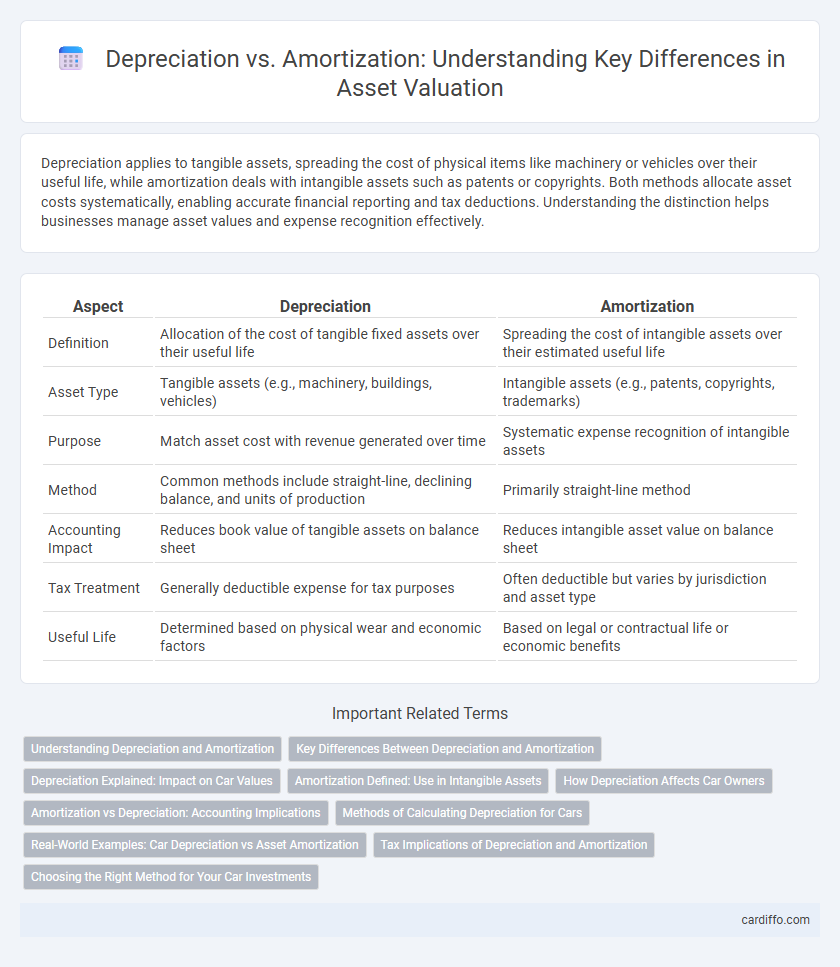Depreciation applies to tangible assets, spreading the cost of physical items like machinery or vehicles over their useful life, while amortization deals with intangible assets such as patents or copyrights. Both methods allocate asset costs systematically, enabling accurate financial reporting and tax deductions. Understanding the distinction helps businesses manage asset values and expense recognition effectively.
Table of Comparison
| Aspect | Depreciation | Amortization |
|---|---|---|
| Definition | Allocation of the cost of tangible fixed assets over their useful life | Spreading the cost of intangible assets over their estimated useful life |
| Asset Type | Tangible assets (e.g., machinery, buildings, vehicles) | Intangible assets (e.g., patents, copyrights, trademarks) |
| Purpose | Match asset cost with revenue generated over time | Systematic expense recognition of intangible assets |
| Method | Common methods include straight-line, declining balance, and units of production | Primarily straight-line method |
| Accounting Impact | Reduces book value of tangible assets on balance sheet | Reduces intangible asset value on balance sheet |
| Tax Treatment | Generally deductible expense for tax purposes | Often deductible but varies by jurisdiction and asset type |
| Useful Life | Determined based on physical wear and economic factors | Based on legal or contractual life or economic benefits |
Understanding Depreciation and Amortization
Depreciation systematically allocates the cost of tangible assets like machinery and vehicles over their useful lives, reflecting wear and obsolescence. Amortization applies similarly to intangible assets such as patents and copyrights, spreading their expense evenly across their defined usage period. Both methods align with the matching principle in accounting, ensuring expenses correspond to the revenues generated within the same fiscal periods.
Key Differences Between Depreciation and Amortization
Depreciation applies to tangible fixed assets such as machinery, vehicles, and buildings, while amortization relates exclusively to intangible assets like patents, trademarks, and goodwill. Depreciation expenses are typically calculated using methods like straight-line or declining balance, reflecting the physical wear and tear of assets, whereas amortization uses the straight-line method based on the asset's estimated useful life or legal duration. Unlike depreciation, amortization does not usually account for salvage value and systematically allocates the cost of intangible assets over their limited useful life.
Depreciation Explained: Impact on Car Values
Depreciation refers to the decrease in a car's value over time due to wear and tear, usage, and aging, significantly impacting resale prices and insurance premiums. Unlike amortization, which applies to intangible assets, depreciation specifically affects tangible assets like vehicles, reflecting their loss in market worth annually. Understanding depreciation helps car owners anticipate future expenses and make informed decisions regarding vehicle purchase and maintenance.
Amortization Defined: Use in Intangible Assets
Amortization is the systematic allocation of the cost of intangible assets, such as patents, trademarks, and goodwill, over their useful lives. Unlike depreciation, which applies to tangible assets like machinery and buildings, amortization specifically addresses non-physical assets without a defined salvage value. This method helps companies match the expense of intangible assets to the periods benefiting from their use, ensuring accurate financial reporting and compliance with accounting standards.
How Depreciation Affects Car Owners
Depreciation significantly impacts car owners by reducing the vehicle's resale value over time as the asset loses worth due to wear, tear, and obsolescence. Unlike amortization, which applies to intangible assets, depreciation specifically accounts for tangible assets like cars, influencing insurance premiums, tax deductions, and trade-in offers. Understanding vehicle depreciation helps owners make informed decisions about maintenance expenses, purchase timing, and overall cost of ownership.
Amortization vs Depreciation: Accounting Implications
Amortization and depreciation both allocate the cost of an asset over its useful life, but amortization applies to intangible assets like patents and copyrights, while depreciation concerns tangible fixed assets such as machinery and buildings. From an accounting perspective, amortization typically uses the straight-line method without residual value, affecting intangible asset valuation and expense recognition. Depreciation methods vary--straight-line, declining balance, or units of production--impacting tax deductions and financial reporting differently due to asset type and usage patterns.
Methods of Calculating Depreciation for Cars
Calculating depreciation for cars typically involves methods such as the straight-line, declining balance, and sum-of-the-years'-digits approaches, each affecting expense recognition differently. The straight-line method evenly spreads the car's cost over its useful life, while the declining balance method accelerates depreciation, reflecting higher expense in earlier years. Sum-of-the-years'-digits provides a middle ground by weighting depreciation based on remaining life, allowing more precise alignment with a car's actual usage and value decline.
Real-World Examples: Car Depreciation vs Asset Amortization
Car depreciation reflects the decline in a vehicle's market value over time due to wear and tear, with an average annual depreciation rate of 15-20% for new cars. Asset amortization, in contrast, applies primarily to intangible assets like patents or trademarks, spreading their cost evenly over their useful life, typically 5-20 years. For example, while a company may depreciate a fleet of delivery trucks annually on a straight-line basis, it amortizes software development costs over a defined period to match the asset's economic benefits.
Tax Implications of Depreciation and Amortization
Depreciation and amortization both reduce taxable income by allocating the cost of assets over their useful lives, but depreciation applies to tangible assets while amortization is for intangible assets. Depreciation allows businesses to recover the cost of physical assets such as machinery or buildings, often providing accelerated methods like MACRS for faster tax deductions. Amortization for intangible assets like patents or copyrights typically follows a straight-line method, impacting tax liabilities differently by spreading expenses evenly over the asset's useful life.
Choosing the Right Method for Your Car Investments
Depreciation applies to tangible assets like vehicles, reflecting wear and tear over time, while amortization is used for intangible assets such as patents or trademarks. Choosing depreciation methods for car investments depends on factors like expected usage, resale value, and tax benefits, with common approaches including straight-line and declining balance methods. Proper selection maximizes tax deductions and accurately represents the car's value reduction on financial statements.
Depreciation vs Amortization Infographic

 cardiffo.com
cardiffo.com